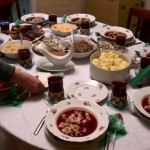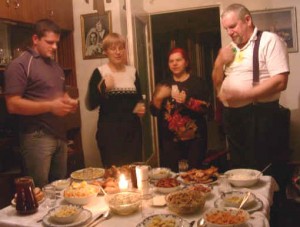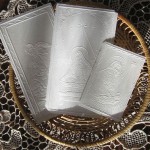
Polish Christmas
Polish Christmas
Advent
A Polish Christmas sometimes includes special tasks carried out in private homes during Advent (a time of waiting for the celebration of the Nativity of Jesus) is the baking of the Christmas piernik (gingerbread), and the making of Christmas decorations. Pierniki are made in a variety of shapes, including hearts, animals, and St. Nicholas figures. Old traditional decorations include handmade stars, decorated eggshells, colorful paper garlands, etc.
 A Polish Christmas features Christmas Trees decorated and lit in family rooms on the day of Christmas Eve. Other trees are placed in most public areas and outside churches. Traditionally the Christmas trees are decorated with hand blown glass baubles, garlands, and many homemade ornaments including shiny red apples, walnuts, wrapped chocolate shapes, and candles. At the top of the tree there is a star or a glittering top piece. In many homes, sparklers are hung on the branches of the trees for wintery ambiance. Sometimes the trees are left standing until February 2, the feast day of St. Mary of the Candle of Lightning.
A Polish Christmas features Christmas Trees decorated and lit in family rooms on the day of Christmas Eve. Other trees are placed in most public areas and outside churches. Traditionally the Christmas trees are decorated with hand blown glass baubles, garlands, and many homemade ornaments including shiny red apples, walnuts, wrapped chocolate shapes, and candles. At the top of the tree there is a star or a glittering top piece. In many homes, sparklers are hung on the branches of the trees for wintery ambiance. Sometimes the trees are left standing until February 2, the feast day of St. Mary of the Candle of Lightning.
During Advent and all the way until Epiphany, or the baptism of Jesus (Sunday of January 6), the “gwiazdory”, or the star carriers walk through the villages. Some of them sing carols; others recite verses or put on “szopki” (puppet shows), or “herody” (nativity scenes). The last two customs are inspired by the traditional manger scenes or “Jaselka” (crib). One tradition unique to Poland is the sharing of the “oplatek”, a thin wafer into which a holy picture is pressed. In the old days people carried these wafers from house to house wishing their neighbors a Merry Christmas. Nowadays, oplatek is mostly shared with members of the family and immediate neighbors before the Christmas Eve supper (Wigilia in the Polish language). As each person shared the wafer they would forgive past trespasses and wish each a healthy and blessed new year.
Wigilia, the Christmas Eve supper
 The focal point of a Polish Christmas is Christmas Eve , which is a day first of fasting, then of feasting. The Wigilia feast begins at the appearance of the first star. There is no red meat served (except fish, usually carp). The supper, which includes many traditional dishes and deserts, can sometimes last for over an hour. It is followed by the exchange of gifts. The next day, the Christmas Day, is often spent visiting friends. In Polish tradition, people combine religion and family closeness at Christmas. Although gift-giving plays a major role in the rituals, emphasis is placed more on the making of special foods and decorations.
The focal point of a Polish Christmas is Christmas Eve , which is a day first of fasting, then of feasting. The Wigilia feast begins at the appearance of the first star. There is no red meat served (except fish, usually carp). The supper, which includes many traditional dishes and deserts, can sometimes last for over an hour. It is followed by the exchange of gifts. The next day, the Christmas Day, is often spent visiting friends. In Polish tradition, people combine religion and family closeness at Christmas. Although gift-giving plays a major role in the rituals, emphasis is placed more on the making of special foods and decorations.
On the night of Christmas Eve, so important is the appearance of the first star in remembrance of the Star of Bethlehem, that it has been given an affectionate name of “the little star” or Gwiazdka (the female counterpart of St. Nicholas). On that evening, children watch the sky anxiously hoping to be the first to cry out, “The star has come!” Only after it appears, the family members sit down to a dinner table.
 According to tradition, bits of hay are spread beneath the tablecloth as a reminder that Christ was born in a manger. Others partake in the practice of placing money under the table cloth for each guest, in order to wish for prosperity in the coming year. Some practice the superstition that an even number of people must be seated around the table. In many homes an empty place setting is symbolically left at the table for the Baby Jesus or, for a lonely wanderer who may be in need of food, or if a deceased relative should come and would like to share in the meal.
According to tradition, bits of hay are spread beneath the tablecloth as a reminder that Christ was born in a manger. Others partake in the practice of placing money under the table cloth for each guest, in order to wish for prosperity in the coming year. Some practice the superstition that an even number of people must be seated around the table. In many homes an empty place setting is symbolically left at the table for the Baby Jesus or, for a lonely wanderer who may be in need of food, or if a deceased relative should come and would like to share in the meal.
The supper begins with the breaking of the oplatek. Everyone at the table breaks off a piece and eats it as a symbol of their unity with Christ. They then share a piece with each family member.
A tradition exists among some families to serve twelve different dishes at Wigilia symbolizing the Twelve Apostles, or perhaps, an odd number of dishes for good luck (usually five, seven, or nine).
A Polish Christmas meal in Poland includes fried carp and borscht (beetroot soup) with uszka (ravioli). Carp provides a main component of the Christmas Eve meal across Poland; carp fillet, carp in aspic etc. Universal Polish Christmas foods are pierogi as well as some herring dishes, and for desert, makowiec or noodles with poppy seed. Often, there is a compote of dry fruits for a drink.
The remainder of the evening is given to stories and songs around the Christmas tree. In some areas of the country, children are taught that “The Little Star” brings the gifts. As presents are unwrapped, carolers may walk from house to house receiving treats along the way.
Christmas Eve ends with Pasterka, the midnight mass at the local church. The tradition commemorates the arrival of the Three Wise Men to Bethlehem and their paying of respect and bearing witness to the new born Messiah. The custom of Christmas night liturgy was introduced in the Christian churches after the second half of the 5th century. In Poland that custom arrived together with the coming of Christianity.
Koledy, the Christmas Carols
Christmas carols are not celebrated in Poland until after the Christmas Vigil Mass. The Christmas season often runs until February 2nd. The early religious hymns sung in Catholic Church were brought to Poland by the Franciscan Brothers already in the Middle Ages. The early Christmas music was Latin in origin. When the Polish words and melodies started to become popular, including many new secular pastorals (pastoralka, or shepherd’s songs), they were not written down originally, but rather taught among people by heart. Many of these early Polish carols were collected in 1838 by Rev. Hioduszewki in a book called Pastoralki i Koledy z Melodiami (Pastorals and Carols with Melodies).